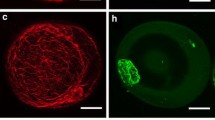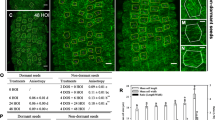Summary
During an earlier investigation, microtubules were observed at the periphery of invasion processes in the developing syncytial tapetum ofTradescantia virginiana L. They were also associated with membranous sacs that accumulate adjacent to tetrads, with putative fusion sites where the tapetal plasmodium is initiated, and, in postmeiotic stages, with the perispore membrane that encloses the developing spore cells. Colchicine was administered to developing flower buds to investigate the roles of these microtubules. The results indicate that microtubules neither initiate nor guide the tapetal invasion of the loculus. The treatments, however, resulted in absence of cell coat from invasion processes and prevention of cell fusion. They also inhibited polarized migration of membrane sacs and removed the associated microtubules. The development of an organized secretory apparatus at the perispore membrane was disrupted, with subsequent disordered deposition of sporopollenin in the extracellular spaces of the partially-fused plasmodium. The results suggest that microtubules participate in the formation and internal spatial organization of the tapetal plasmodium, and establishment of a secretory surface that normally produces sporopollenin at the tapetum-microspore interface.
Similar content being viewed by others
References
Atkinson AW Jr, Gunning BES, John PCL (1972) Sporopollenin in the cell wall ofChlorella and other algae: ultrastructure, chemistry, and incorporation of14C-acetate studied in synchronous cultures. Planta 107: 1–32
Dickinson HG (1970) The fine structure of a peritapetal membrane investing the microsporangium ofPinus banksiana. New Phytol 69: 1065–1068
— (1976) Common factors in exine deposition. In:Ferguson IK, Muller J (eds) The evolutionary significance of the exine, The Linnean Society, London, pp 67–89
—,Bell PR (1973) The identification of sporopollenin in sections of resin embedded tissue by controlled acetolysis. Stain Technol 48: 17–22
Echlin P (1971 a) The role of tapetum in microsporogenesis of angiosperms. In:Heslop-Harrison J (ed) Pollen: development and physiology. Butterworths, London, pp 41–62
— (1971 b) Production of sporopollenin by the tapetum. In:Brooks J, Grant PR, Muir M, van Gijzel P, Shaw G (eds) Sporopollenin. Academic Press, London, pp 220–247
Godwin H, Echlin P, Chapman B (1967) The development of the pollen grain wall inIpomoea purpurea L. (Roth). Rev Palaeobot Palynol 3: 181–195
Gunning BES, Hardham AR (1982) Microtubules. Ann Rev Pl Physiol 33: 651–698
Hart JW, Sabnis DD (1976) Colchicine and plant microtubules: a critical evaluation. Curr Adv Pl Sci 26: 1095–1104
Heslop-Harrison J (1969) An acetolysis-resistant membrane investing tapetum and sporogenous tissue the anthers of certain compositae. Can J Bot 47: 541–542
— (1971 a) The pollen wall: structure and development. In:Heslop-Harrison J (ed) Pollen: development and physiology. Butterworths, London, pp 75–98
— (1971 b) Sporopollenin in biological context. In:Brooks J, Grant PR, Muir M, van Gijzel P, Shaw G (eds) Sporopollenin, Academic Press, New York, pp 1–30
— (1972) Sexuality of angiosperms. In:Steward FC (ed) Plant physiology, a treatise, vol VI C. Academic Press, New York, pp133–289
— (1974) The physiology of pollen grain surface. Proc R Soc Lond B190: 275–299
McKerracher LJ, Heath BE (1985) Microtubules around migrating nuclei in conventionally-fixed and freeze-substituted cells. Protoplasma 125: 162–172
Mepham RH (1970) Development of the pollen grain wall: further work withTradescantia bracteata. Protoplasma 71: 39–54
—,Lane G (1969) Formation and development of the tapetal periplasmodium inTradescantia bracteata. Protoplasma 68: 175–192
Misset MT, Gourret JP (1984) Accumulation of smooth cisternae in the tapetal cells ofUlex europaeus L. J Cell Sci 72: 65–74
Mollenhauer HH, Morré JD (1976) Cytochalasin B, but not colchicine, inhibits migration of secretory vesicles in root tips of maize. Protoplasma 87: 39–48
Oross JW, Thomson WW, (1982) The ultrastructure of the salt glands ofCynodon andDistichlis (Poaceae). Am J Bot 69: 939–949
Pacini E, Juniper BE (1983) The ultrastructure of the formation and development of the amoeboid tapetum inArum italicum Miller. Protoplasma 117: 116–129
Pettitt JM (1966) A new interpretation of the structure of the megaspore membrane in some gymnospermous ovules. J Linn Soc (Bot) 59: 253–263
Picton JM, Steer MW (1981) Determination of secretory vesicle production rates by dictyosomes in pollen tubes ofTradescantia using cytochalasin D. J Cell Sci 49: 261–272
Rowley JR, Southworth D (1967) Deposition of sporopollenin on lamellae of unit membrane dimensions. Nature 213: 703–704
Ryan KG (1984) Membranes in the spindle ofIris pollen mother cells during the second division of meiosis. Protoplasma 122: 56–67
Tiwari SC, Gunning BES (1986 a) Cytoskeleton, cell surface and development of invasive tapetum inTradescantia virginiana. Protoplasma 133: 89–99
— — (1986 b) An ultrastructural, cytochemical and immunofluorescence study of post-meiotic development of plasmodial tapetum inTradescantia virginiana L. and its relevance to the pathway of sporopollenin secretion. Protoplasma 133: 100–114
- - (1986 c) Development and cell surface of a non-syncytial invasive tapetum in Canna: ultrastructural, freeze-substitution, cytochemical and immunofluorescence study. Protoplasma (in press)
Volkmann D, Czaja AWP (1981) Reversible inhibition of secretion in root cap cells of cress after treatment with cytochalasin B. Support for the membrane flow concept. Exp Cell Res 135: 229–236
Author information
Authors and Affiliations
Rights and permissions
About this article
Cite this article
Tiwari, S.C., Gunning, B.E.S. Colchicine inhibits plasmodium formation and disrupts pathways of sporopollenin secretion in the anther tapetum ofTradescantia virginiana L.. Protoplasma 133, 115–128 (1986). https://doi.org/10.1007/BF01304627
Received:
Accepted:
Issue Date:
DOI: https://doi.org/10.1007/BF01304627




